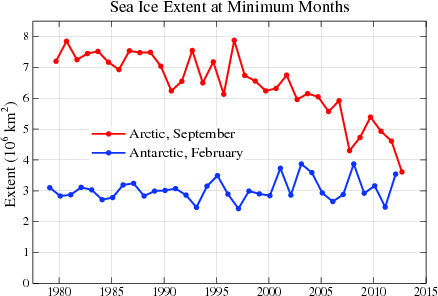Monckton Myth #6: Global Sea Ice
Posted on 22 January 2011 by James Wight
 As part of an ongoing series looking at Christopher Monckton’s response to Mike Steketee, this post examines Monckton’s arguments about global sea ice. Monckton claims:
As part of an ongoing series looking at Christopher Monckton’s response to Mike Steketee, this post examines Monckton’s arguments about global sea ice. Monckton claims:
[T]he global sea ice record shows virtually no change throughout the past 30 years, because the quite rapid loss of Arctic sea ice since the satellites were watching has been matched by a near-equally rapid gain of Antarctic sea ice.
Global Sea Ice Is Decreasing
Have Arctic ice losses truly been balanced by Antarctic gains? The first point to clarify is that we are talking about floating sea ice, not to be confused with land ice. Land ice at both poles and in glaciers around the world is sliding into the ocean at an accelerating rate. This net loss of land ice is contributing to sea level rise.
However, Monckton is clearly referring to sea ice. The rapid decline of Arctic sea ice has indeed coincided with an increase in Antarctic sea ice. But do these two opposite trends cancel out as Monckton suggests? In reality, the upward Antarctic trend is only slight compared to the plummeting Arctic trend. Tamino has crunched the numbers and found the Arctic trend is in fact more than three times faster than the Antarctic one. The net result is a statistically significant global decrease of more than a million km2 or a few percent – would you agree with Monckton that this is “virtually no change”?

Figure 1: Global sea ice extent since 1979. (Image source: Tamino. Data is from US National Snow and Ice Data Center.)
(UPDATE: Sea ice area data shows the same thing as extent data.)
Summer and Winter, Apples and Oranges
Monckton continues:
Indeed, when the summer extent of Arctic sea ice reached its lowest point in the 30-year record in mid-September 2007, just three weeks later the Antarctic sea [sic] extent reached a 30-year record high. The record low was widely reported; the corresponding record high was almost entirely unreported.
Here Monckton is comparing the Arctic summer to the Antarctic winter, not the most appropriate comparison. Sea ice grows and shrinks seasonally because polar latitudes have vastly more daylight hours in summer than in winter. When ice melts, it makes the surface less reflective and amplifies the warming (as is currently occurring in the Arctic), but this effect can only make a difference when the Sun is up. Thus the most important time of year for sea ice is its annual minimum which occurs at the end of the summer: September in the Arctic but February in the Antarctic.
So how do the two compare?

Figure 2: Minimum sea ice extent since 1979 in the Arctic and Antarctic. (Image source: James Hansen. Data is from US National Snow and Ice Data Center.)
While the summer Arctic has lost an extent of about 2.5 million km2 (equivalent to the area of Western Australia), the summer Antarctic growth is only 0.3 million km2 (about the size of Victoria). Even that slight upward trend is less than the year-to-year variability; although 2003 and 2008 tied for the highest February extent, 2006 was third lowest. Again, the real world contradicts Monckton’s assertion that changes in the Arctic are being balanced out by the Antarctic.
The Third Dimension
Furthermore, Monckton fails to mention that Arctic sea ice is not only shrinking in extent but also has been thinning rapidly. Although its lowest extent was in 2007, its volume has continued declining since then, hitting another record low in 2010:

Figure 3: Arctic sea ice volume since 1979. (Image source: Wikipedia. Based on data from University of Washington Polar Science Center.)
The volume data is supported by a sharp decline in thick multiyear ice, from around 60% of ice cover in the 1980s to just 15% in 2010:

Figure 4: September Arctic sea ice age since 1981. (Source: US National Snow and Ice Data Center.)
Meanwhile there has been a slight increase in Antarctic sea ice volume, but only by about 5,000 km3 (insufficient to offset the Arctic decline shown in figure 3) and most of it in a few years at the start of the record.
The Polar Prognosis
As thinner and younger ice is easier to melt, the rapid Arctic melt is set to continue; ice-free summers are now probably inevitable. In contrast, the Antarctic increase is occurring despite the warming of the Southern Ocean and is expected to reverse as the warming continues. Antarctic sea ice is just a distraction from the accelerating losses from ice sheets and the looming specter of a sea-ice-free Arctic.































 Arguments
Arguments






























This is figure 8 from Historical variability of sea ice edge position in the Nordic Seas which shows that the current decline is steeper than the long term decline but that there is a long term decline.
This is local, not global, as I noted in #5. There is no accurate world wide data prior to the satellite era, just Nordic data and Russian data.
In this case, the "alarmist" is nature itself which reacted more strongly than even the IPCC's worst case scenario.